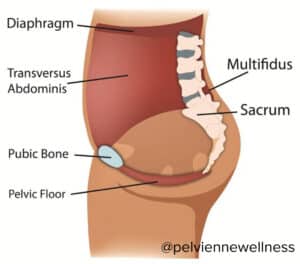This post may contain affiliate links to items I love, and I am confident you will too! All opinions are my own, however, I may receive a small commission on purchases. As an Amazon Associate I earn from qualifying purchases. For any health advice I give on nutrition and weight loss, make sure you check with your doctor, as I am not a health professional.
By now, everyone has heard of Kegels. It’s a buzzword and everyone is getting in on the trend. But do you really know what they are?? I mean really?? I didn’t think so. I am a pelvic health Physical Therapist and let me tell you, you are not alone.
It’s estimated that roughly 80% of women don’t know what the correct muscles are, where to find them, how to use them and if they are even using them correctly when they do find them. I see this day in and out in my practice. So let’s start at the beginning shall we??
Your Pelvic Floor
Kegels are a fancy term for pelvic floor exercises. They are named after the American Gynecologist Arnold Kegel who discovered how working this group of muscles was so beneficial. The pelvic muscles basically form your undercarriage at the bottom of your pelvis.
There are 15 different vaginal muscles in 3 layers and they go from your pubic bone in front, to your sitz bones/hip on the side and to your tail bone in the back. They are, in fact, my favorite muscles in the whole body, and really are the centre of the universe, holding up all the pelvic organs.

When they are working well, life is good. When there are pelvic floor disorders, life is not so good. We are talking about urine leakage, fecal incontinence or bowel control, pelvic organ prolapse, pelvic girdle pain, and even pelvic pain during sex (dyspareunia).
Problems can stem from a fall on your tailbone, pregnancy, birthing (vaginal or belly), surgery, trauma, or even “no reason at all” which is really just the nervous system being a little too overprotective. The pelvic floor dysfunction you are experiencing will dictate which pelvic floor exercise routine is best suited for you. Did I mention there are 13 different types of kegels??
How to Connect with Your Pelvic Floor
Before we get into all the ways you can connect with your pelvic floor muscles, let’s start with how to find the right muscles. My least favorite way is to stop the flow of urine, but in a pinch you can test it that way. A much more accurate way is to feel the muscles directly. You can sit on your hand and contract your pelvic floor muscles. You should feel a lift of your perineum, and not a bulge downward.
Alternatively, you can place a clean finger inside your vagina and contract. You should feel a squeeze and a lift. If it is difficult or painful to get your finger in, the muscles of the pelvic floor may be tight and will be better suited to start with the releases or reverse kegels (flower bloom ex’s below).
If you don’t feel much, try inserting a second or third finger in until you can feel the walls of your vagina. This may indicate that you have a lax pelvic floor and doing these pelvic floor muscle exercises correctly could be of huge benefit to you. Both of these scenarios could indicate a weak pelvic floor.

Training Your Pelvic Floor
So here is how to do pelvic floor muscle training correctly. You can try them first, then sit on your hand or insert your fingers.
The Core BreathInhale to expand: As you inhale, feel the air going into your back and side ribs, allowing your pelvic floor to lengthen, drop and expand Exhale to engage: As you exhale pick up an imaginary blueberry with your vagina (and/or urethra, and/or anus), and draw them up and into your body. Feel a band of tightness around your lower belly as transversus connects with pelvic floor. Repeat Inhale to expand and Exhale to engage for several breaths.
Now for those of you that had pain with insertion, just do the first part, Flower Bloom or Reverse Kegel. Similar to the Core Breath, but there is no voluntary contraction (aka picking up of blueberries).

Flower Bloom: Inhale to expand: As you inhale, feel the air going into your back and side ribs, allowing your pelvic floor to lengthen, drop and expand,**Imagine a flower blooming, opening petals to the big bright sun. Exhale and do nothing, allow the flower to softly close for the nightRepeat flower bloom, flower closes for the night
And everyone needs to remember, this isn’t a strength competition! You are not going to be carrying surfboards or bowling balls with your strong pelvic floor muscles. Quality is much more important than power here. And even more important is function…can you do this in a standing position and moving?
Cross Training Your Pelvic Floor
It is a good idea to mix and match positions as you do this form of exercise, the muscles of your pelvic floor must work in all positions. Initially, make sure you have a neutral spine, as it is easier to connect with your pelvic floor. Then mix it up. If the breathing part is messing with you, just breathe. In real life, our pelvic floor needs to work no matter where we are in the breath cycle.
The pelvic floor also has many different roles, and needs strength, coordination, endurance, timing, and control to function optimally. Therefore, different types of pelvic muscle exercises are beneficial. So just like you use a cross training exercise program to work towards a marathon with short runs, long runs, speed work and hills, so too should you “cross train” your pelvic floor with the 13 different types of kegels for effective treatment: stairs, elevators, pulses, locking, crowns, holds and my favorite…the temptress. The good news is there are numerous benefits but one thing that definitely improves with kegels is sexual function, so why not integrate these kegels with a partner? Pure Pleasure!

Keep It Up
So how many reps and sets should you do?? You will notice I did not give you 3 sets of 10! These are motor patterning exercises, not fitness! It is more important that you do each simple exercise perfectly. When you start to “loose it”, reset or change positions and try again. If you aren’t “getting it” then you are done. Come back 5 minutes or 5 hours later and try again or do a different one.
The great thing is many small sets with perfect reps will is the first step to get the motor patterning and coordination we are looking for! So, do as many of each as you can perfectly as many times a day as you can sneak in using the right set of muscles. And remember to have fun. Mix them up! They do not need to all be done at once or even each day. Each exercise has a different purpose. Have fun with them!
Contributed by:
Julia Di Paolo
Related articles:



